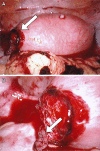Heterotopic triplet pregnancy: report of a patient with remnant tubal ectopic and intrauterine twin pregnancy after frozen-thawed embryo transfer
- PMID: 29699100
- PMCID: PMC5906961
- DOI: 10.1007/s12522-011-0098-1
Heterotopic triplet pregnancy: report of a patient with remnant tubal ectopic and intrauterine twin pregnancy after frozen-thawed embryo transfer
Abstract
A case of heterotopic triplet pregnancy after frozen-thawed embryo transfer is presented. The patient conceived after transfer of three frozen-thawed embryos at a fertility clinic where she had previously undergone laparoscopic left salpingectomy due to pyosalpinx. Approximately 4 weeks after the embryo transfer, she presented with a complaint of abnormal genital bleeding and was diagnosed by ultrasound as having a dichorionic twin pregnancy. One week later, she was referred to our hospital because of lower abdominal pain. Hematoperitoneum was suspected based on findings of low blood pressure and tachycardia. Diagnostic emergent laparoscopy demonstrated an ectopic pregnancy in the remnant isthmic portion of the left tube. Laparoscopic excision of the remnant fallopian tube was performed, but the procedure resulted in early-pregnancy loss of one of the twins. The risk of heterotopic pregnancy is not small under assisted reproductive technology. Attention should be paid to the risk of tubal pregnancy after transferring more than two embryos or controlled ovarian hyperstimulation, even after salpingectomy has been performed.
Keywords: Heterotopic pregnancy; In vitro fertilization and embryo transfer; Laparoscopic surgery; Remnant fallopian tube.
Figures




Similar articles
-
Two cases of intrauterine pregnancy with tubal stump pregnancy after in vitro fertilization and embryo transfer following ipsilateral salpingectomy: A case report.Medicine (Baltimore). 2019 Dec;98(49):e18183. doi: 10.1097/MD.0000000000018183. Medicine (Baltimore). 2019. PMID: 31804336 Free PMC article.
-
Unilateral twin tubal pregnancy and subsequent heterotopic pregnancy in a patient following in vitro fertilization.Acta Clin Croat. 2009 Sep;48(4):451-4. Acta Clin Croat. 2009. PMID: 20405643
-
Heterotopic Pregnancy After In Vitro Fertilization and Embryo Transfer After Bilateral Total Salpingectomy/Tubal Ligation: Case Report and Literature Review.J Minim Invasive Gynecol. 2016 Mar-Apr;23(3):338-45. doi: 10.1016/j.jmig.2015.11.013. Epub 2015 Dec 10. J Minim Invasive Gynecol. 2016. PMID: 26687016 Review.
-
Rare Occurrence of Left Ampullary Ectopic Pregnancy After Ligation of the Left Fallopian Tube: A Case Report.Int J Womens Health. 2023 Jul 4;15:965-970. doi: 10.2147/IJWH.S417186. eCollection 2023. Int J Womens Health. 2023. PMID: 37424698 Free PMC article.
-
A rare case of heterotopic pregnancy after a single embryo transfer: A case report and literature review.J Obstet Gynaecol Res. 2021 Oct;47(10):3707-3711. doi: 10.1111/jog.14923. Epub 2021 Jul 12. J Obstet Gynaecol Res. 2021. PMID: 34254398 Review.
Cited by
-
Heterotopic triplet pregnancy after in vitro fertilization with favorable outcome of the intrauterine twin pregnancy subsequent to surgical treatment of the tubal pregnancy.Case Rep Obstet Gynecol. 2014;2014:356131. doi: 10.1155/2014/356131. Epub 2014 Jan 12. Case Rep Obstet Gynecol. 2014. PMID: 24527252 Free PMC article.
-
Heterotopic Triplet Pregnancy After Assisted Reproductive Techniques: A Systematic Review.Cureus. 2024 Dec 19;16(12):e75997. doi: 10.7759/cureus.75997. eCollection 2024 Dec. Cureus. 2024. PMID: 39835041 Free PMC article. Review.
References
-
- DeVoe RW, Pratt JH. Simultaneous intrauterine and extrauterine pregnancy. Am J Obstet Gynecol, 1948, 56, 1119–1126 - PubMed
-
- Kasum M, Grizelj V, Simunic V. Combined interstitial and intrauterine pregnancies after in vitro fertilization and embryo transfer. Hum Reprod, 1998, 13, 1547–1549 10.1093/humrep/13.6.1547 - DOI - PubMed
-
- Pan HS, Chuang J, Chiu SF, Hsieh BC, Lin YH, Tsai YL et al. Heterotopic triplet pregnancy: report of a case with bilateral tubal pregnancy and an intrauterine pregnancy. Hum Reprod, 2002, 17, 1363–1366 10.1093/humrep/17.5.1363 - DOI - PubMed
-
- Dor J, Seidman DS, Levran D, Ben‐Rafael Z, Ben‐Shlomo I, Mashiach S. The incidence of combined intrauterine and extrauterine pregnancy after in vitro fertilization and embryo transfer. Fertil Steril, 1991, 55, 833–834 - PubMed
-
- Chang Y, Lee JN, Yang CH, Hsu SC, Tsai EM. An unexpected quadruplet heterotopic pregnancy after bilateral salpingectomy and replacement of three embryos. Fertil Steril, 2003, 80, 218–220 10.1016/S0015‐0282(03)00547‐8 - DOI - PubMed
LinkOut - more resources
Full Text Sources
